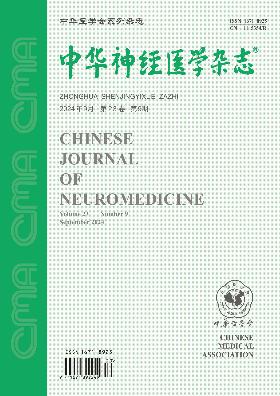Efficacy and safety of endovascular recanalization 6-24 h after onset in patients with acute basilar artery occlusion
Q4 Medicine
引用次数: 0
Abstract
Objective To investigate the efficacy and safety of endovascular recanalization 6-24 h after onset in patients with acute basilar artery occlusion, and explore the related factors for their prognoses. Methods Clinical data of 37 patients with acute basilar artery occlusion, received endovascular recanalization in our hospital from January 2016 to July 2019, were retrospectively collected; 23 patients were into group of onset-to-puncture time (OPT)>6 h (6-24 h), and 14 patients were into group of OPT≤6 h (0-6 h). Statistical methods were used to compare the postoperative symptomatic intracranial hemorrhage rate, good prognosis rate (modified Rankin scale [mRS] scores≤3) and mortality 3 months after onset between the two groups; clinical data between the subgroups with good and poor prognoses in patients of group of OPT>6 h were compared. Results The postoperative symptomatic intracranial hemorrhage rate, and good prognosis rate and mortality of patients from group of OPT>6 h were 30.4%, 47.8% and 43.5%, respectively; and there were no statistically significant differences as compared with those in patients from group of OPT≤6 h (35.7%, 35.7%, and 42.9%, P>0.05). Scores of scales based on preoperative CTA images(posterior circulation-Alberta stroke program early CT scale [pc-ASPECTS], scale of posterior circulation on CTA [pc-CTA], and scale of basilar artery on CTA [BATMAN]) showed significant differences between the good prognosis subgroup and poor prognosis subgroup in patients from group of OPT>6 h (P<0.05). Conclusion Endovascular recanalization 6-24 h after onset is effective in patients with acute basilar artery occlusion, and the safety does not obviously decrease; scores of pc-ASPECTS, pc-CTA and BATMAN may be related to the clinical prognoses. Key words: Basilar artery occlusion; Time-window; Endovascular therapy; Curative effect; Safety急性基底动脉闭塞患者发病后6-24小时血管内再通的疗效和安全性
目的探讨急性基底动脉闭塞患者发病后6 ~ 24 h血管内再通术的疗效和安全性,并探讨影响其预后的相关因素。方法回顾性收集我院2016年1月至2019年7月收治的37例急性基底动脉闭塞行血管内再通术患者的临床资料;将23例患者分为发作至穿刺时间(OPT)≤6 h组(6 ~ 24 h), 14例患者分为OPT≤6 h组(0 ~ 6 h)。采用统计学方法比较两组患者术后症状性颅内出血率、良好预后率(改良Rankin量表[mRS]评分≤3分)及发病后3个月死亡率;比较OPT组患者预后良好亚组和预后不良亚组的临床资料。结果OPT组患者术后症状性颅内出血率为30.4%,预后良好率为47.8%,病死率为43.5%;与OPT≤6 h组比较,差异无统计学意义(分别为35.7%、35.7%和42.9%,P < 0.05)。基于术前CTA图像的评分(后循环-阿尔伯塔卒中程序早期CT评分[pc-ASPECTS]、CTA后循环评分[pc-CTA]、CTA基底动脉评分[BATMAN])在OPT组患者预后良好亚组和预后不良亚组之间的差异有统计学意义(P<0.05)。结论急性基底动脉闭塞6 ~ 24 h血管内再通是有效的,且安全性没有明显降低;pc-ASPECTS、pc-CTA和BATMAN评分可能与临床预后有关。关键词:基底动脉闭塞;时间窗;血管内治疗;疗效;安全
本文章由计算机程序翻译,如有差异,请以英文原文为准。
求助全文
约1分钟内获得全文
求助全文
来源期刊

中华神经医学杂志
Psychology-Neuropsychology and Physiological Psychology
CiteScore
0.30
自引率
0.00%
发文量
6272
期刊介绍:
 求助内容:
求助内容: 应助结果提醒方式:
应助结果提醒方式:


